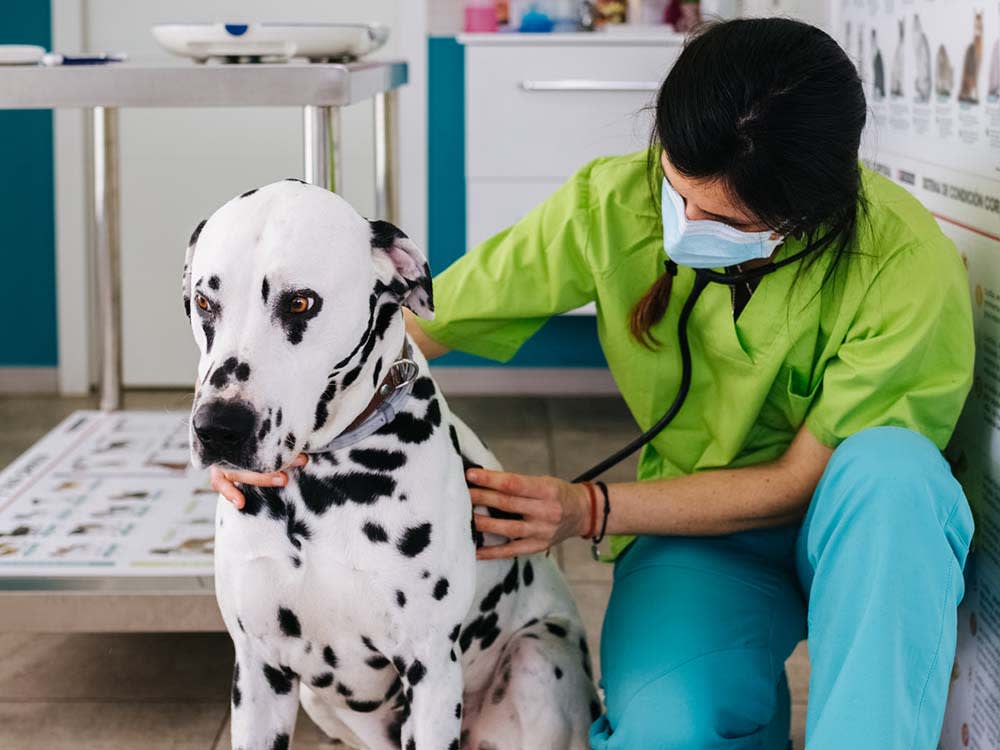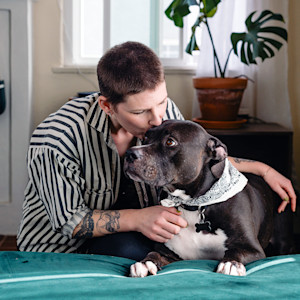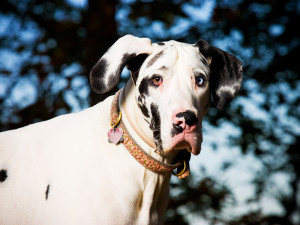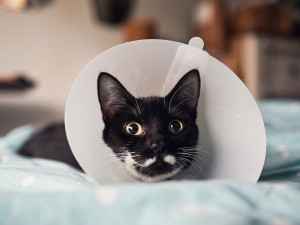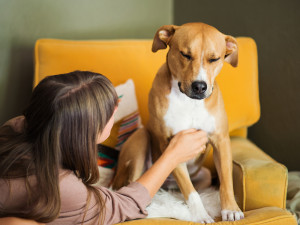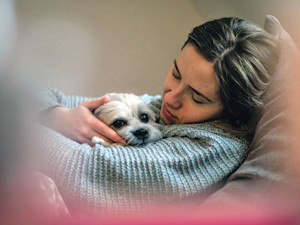Why Is Your Dog’s Stomach Hard? What to Give a Bloated Dog
And when to be concerned.
In This Article:
What Is Bloat in Dogs? Symptoms of Bloat in Dogs What Causes Bloat in Dogs? Bloat in Dogs: Treatment
It’s rarely a good sign when you get to skip the line at a busy emergency vet clinic, and few conditions prompt a faster response than bloat in dogs. The problem is serious enough that your dog will be whisked into the treatment area for an examination and stomach x-rays if there’s even a suspicion of bloat.
Although the risk of bloat in some breeds is low, it’s important to be familiar with the condition so you can recognize dog bloat symptoms early and seek prompt veterinary care.
Snap a pic of your pup’s teeth, and GREENIES™ will help you spot potential signs of oral health issues.
How much do you spend on your pet per year?
What is bloat in dogs?
I’ve worked in emergency clinics for my entire career, so I’ve seen dozens of dogs with bloat. The most common history I hear from pet parents sounds like this: “Everything was fine just a couple of hours ago. I fed my dog and he went out to play like normal. He wasn’t as active as he usually is but kept pacing around. I checked him out and his belly seemed big and kind of hard. He started trying to throw up after but never brought anything up. He collapsed on the way here and seems too weak to get up.”
Bloat, which is formally known as gastric dilatation and volvulus (or GDV), is an emergency condition of dogs. The “gastric dilatation” part of GDV means that the stomach is markedly enlarged, usually with gas. “Volvulus” means that the stomach has twisted on itself, blocking off the paths to empty itself. The stomach can twist anywhere from 180 to 360 degrees off its usual axis.
As the stomach twists, its entry from the esophagus and exit to the intestines get blocked off. Gas builds up in the stomach quickly, causing progressive distension and putting pressure on the major blood vessels near it. This pressure can be so severe that it stops blood from the back half of a dog’s body from returning to the heart. There’s no definitive dog-bloat timeline, but things can progress from normal to life-threatening in as little as an hour.
Symptoms of bloat in dogs
If you’re in tune with your dog’s usual behavior, bloat symptoms are not subtle and should be a major red flag. Although some of these symptoms overlap with other conditions, it’s never safe to just ignore them and assume it’s something minor. Time is vital in getting bloat treated, so it’s best to take your dog to the vet immediately if you think GDV is possible.
Some common dog bloat symptoms include:
Anxiety: This is often an early sign of bloat. Dogs can feel something has gone wrong before other symptoms become obvious and may be agitated or seek attention from their parents.
Restlessness and pacing: As the stomach expands, dogs have increasing trouble finding a comfortable position when sitting or lying down. This leads to up-and-down behavior or constant pacing.
Non-productive retching: This is one of the most common and easily recognizable signs of bloat. Dogs with bloat will usually repeatedly try to empty their stomach as it stretches, but they’re unable to bring anything up because it has twisted. The retch can almost sound like a roar sometimes. A little bit of foamy saliva may be produced during these attempts but shouldn’t be confused for stomach contents.
Drooling: This may occur either due to nausea from the stretching of the stomach or an inability to swallow effectively because of the twisting of the esophagus.
Swollen or distended stomach: The rapidly growing stomach may become visible behind the ribcage as it expands. Despite its large size, the stomach may never become visible in some exceptionally deep-chested breeds like Great Danes. A bloated abdomen in dogs can occur for a few different reasons, but a sudden change in the appearance of your dog’s belly is a cause for alarm.
Hard or tense abdomen: As the stomach expands, the abdomen will become firm from both the physical pressure of the stomach on the other organs and the discomfort caused by the condition.
Looking or chewing at the abdomen: Dogs will often look, lick, or chew at areas of their body that are bothering them. With bloat, dogs may turn to the side to focus on their belly.
Labored breathing or panting: The stomach can get so large that it impairs the ability of the lungs to expand fully. The pressure of the stomach on the diaphragm and ribs makes it hard for dogs to breathe normally.
Pale gums: As the stomach gets larger, less and less blood returns to the heart. Pale gums are a sign of poor blood flow and poor oxygenation.
Weakness: The decrease in blood flow also means a drop in blood pressure. This results in weakness and collapse as time passes and signs worsen.
What causes bloat in dogs?
Despite GDV being a relatively common condition, not much is known about how it actually occurs. Research in the past decade on the makeup of the gas within the bloated stomach indicates that the stomach likely twists before it expands, but this is not known with certainty. Over time, studies have shown some risk factors for bloat in dogs. This doesn’t tell us what triggers the stomach to twist, but it does allow us to give some recommendations to lower the odds a dog will bloat.
Some reported risk factors for bloat include:
Breed and conformation: Although any dog can develop GDV, large- and giant-breed dogs with deep chests seem to be most at risk. Some breeds disproportionately affected by bloat include Great Danes, German Shepherds, Doberman Pinschers, Boxers, and Standard Poodles.
Increasing age: Age is one of the most consistent risk factors for bloat. While it can occur in young dogs (and even puppies), middle-age to senior dogs suffer from this condition most commonly.
Having close relatives with bloat: Having a first-degree relative who has bloated significantly increases the risk of bloat for a dog. This indicates that there may be a genetic component to the disease.
Dietary factors: Eating from an elevated food bowl seems to be a major risk factor for large- and giant-breed dogs developing bloat. Other diet-related things associated with an increased risk of bloat include being fed only one meal a day, overeating, eating rapidly, and small kibble size.
Gastric foreign bodies: One study found that having foreign material in the stomach greatly increases the chances a dog will develop bloat. It’s not clear if the material causes the bloat or if dogs at risk for bloat seek out abnormal things to eat.
Exercise after eating: Going out to exercise right after eating has long been recognized as a risk factor for developing bloat. Large- and giant-breed dogs should be encouraged to settle for a while after meals.
Being thin or underweight: An overly lean body condition may predispose dogs to bloat. Maintaining an appropriate (but not overweight) weight is important in overall health.
Environmental conditions: Dramatic drops in temperature have been associated with an increased incidence of bloat.
These risk factors for bloat are not consistent across every study, making it even more difficult to link certain behaviors to risk. There’s also limited information available on proactive steps to take to avoid the issue. Some things that may help include supplementing the diet of large- or giant-breed dogs with table or canned food, providing egg or fish dietary supplements, and participating in moderate exercise. Always consult with your veterinarian before changing your dog’s diet or adding dietary supplements.
Bloat in dogs: Treatment
Bloat is a surgical problem. The stomach needs to be untwisted and then secured to the body wall in its normal position to prevent it from twisting again. Getting a dog with bloat to and through surgery can be a challenge, but it’s something that emergency vets are prepared for.
Lots of things will happen very quickly when a dog with bloat shows up. While it’s impossible to cover treatment for every possible complication associated with bloat, the general care picture includes:
Stabilization
Stabilization involves placing IV catheters, giving a bolus of fluids and starting pain control. The veterinarian will often do their examination as catheters are placed and blood is drawn for testing. If a dog is in severe distress, the stomach may be decompressed before confirming the presence of a bloat. Getting the pressure off quickly can be lifesaving.
Confirmation
Most presentations of GDV are easily identified on abdominal radiographs (x-rays). Chest radiographs may be done to rule out the presence of metastatic cancer in older dogs before proceeding to surgery. Blood work can show if any systemic issues need to be addressed before anesthesia and may give an idea about the likelihood of severe damage to the stomach.
Decompression
Getting the built-up gas out of the stomach relieves pressure on the blood vessels and helps significantly with shock symptoms. This can either be done by passing a large needle through the skin and directly into the stomach or by passing a large-diameter tube down the throat and into the stomach. Passing a tube allows for more thorough emptying of the stomach contents, but it generally requires heavy sedation and can be challenging when the stomach is very distended.
Discussion
Once bloat is confirmed, the veterinarian can talk with the dog’s family about the condition, treatment, possible complications, prognosis, and cost. About 80 to 85 percent of dogs that go to surgery for bloat survive and go home, but it’s important that everyone is on the same page before committing to a major surgery. Euthanasia is the kindest option for dogs of families who do not feel that surgery is the right choice.
Surgery
Prior to or during surgery, the stomach is emptied completely, making it easier to untwist. The stomach is evaluated to make sure it looks healthy and that there are no areas that have lost their blood supply. Because the spleen often rotates with the stomach, it is also examined to make sure its blood supply hasn’t been compromised. The pylorus (the exit of the stomach) is sutured to the body wall on the dog’s right side in its normal position.
Post-operative care
Dogs are usually in the hospital for 24 to 72 hours after bloat surgery. Before releasing a dog after surgery, vets usually want to make sure that pain is controlled, appetite has returned, and the heart rate remains normal. Dogs are usually kept on activity restriction at home for 10 to 14 days after discharge.
When to seek expert help for bloat
If you’re noting any dog bloat symptoms at home, get to a vet as soon as possible. If you’re able, calling ahead can help the team there to prep for an emergency. There’s no way to treat bloat at home, so there’s no point in wasting time if you’re worried your dog is bloated.
Bottom line
Bloat is a serious emergency that primarily affects large- and giant-breed dogs. Because bloat progresses so quickly, it’s vital to bring any dog suspected of being bloated to the vet as soon as possible. With appropriate care and surgery to correct the condition, most dogs will do well despite the severity of the condition. Preventative surgery is available for large- and giant-breed dogs at risk for bloat
References
de Battisti, Anna et al. “Gastric foreign body as a risk factor for gastric dilatation and volvulus in dogs.” Journal of the American Veterinary Medical Association vol. 241,9 (2012): 1190-3. doi:10.2460/javma.241.9.1190opens in new tab.
Glickman, L T et al. “Non-dietary risk factors for gastric dilatation-volvulus in large and giant breed dogs.” Journal of the American Veterinary Medical Association vol. 217,10 (2000): 1492-9. doi:10.2460/javma.2000.217.1492opens in new tab.
Sartor, Angela J et al. “Association between previous splenectomy and gastric dilatation-volvulus in dogs: 453 cases (2004-2009).” Journal of the American Veterinary Medical Association vol. 242,10 (2013): 1381-4. doi:10.2460/javma.242.10.1381opens in new tab.
Van Kruiningen, H J et al. “Stomach gas analyses in canine acute gastric dilatation with volvulus.” Journal of veterinary internal medicine vol. 27,5 (2013): 1260-1. doi:10.1111/jvim.12138opens in new tab.
